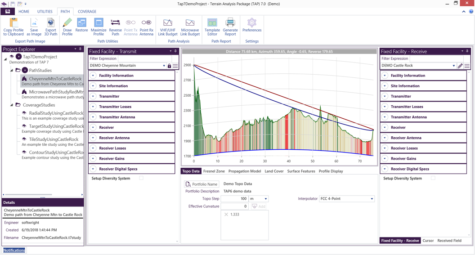The Land Use module imports USGS National Land Cover Database (NLCD) files and WorldCover ESA global land cover files and uses them in the radio coverage predictions and link analyses. The USGS NLCD files categorize land use attributes, such as Urban, Agricultural, Forest, etc. When the files are imported into the TAP™ format, TAP™ can determine the classification at a given set of coordinates. The land cover data may be used to enhance propagation analyses to two primary ways:
- Loss values may be defined for any frequency ranges for each specified type of land use to permit the inclusion of localized environmental conditions in predicted system performance. Recommended loss values are readily available.
- Land Cover Clutter can be used to raise the terrain along an RF path based on the land cover category. Click here to see a tutorial video of how to include Land Cover Clutter in Propagation Studies.
As shown below, the land cover category can be shown graphically along a path study. This can aid in the consideration of where trees or buildings may impact link performance and inform the placement of appropriate surface features. It can also help identify where possible reflection points along the path may be especially problematic due to the presence of water.
In addition, TAP™ includes a Land Use Loss Database that correlates the land classification with a loss value as a function of frequency. When TAP™ is used for an area coverage study or single-point field calculation, the environment of the receiver location can be determined from the Land Use data, and a user-specified loss value can be applied. For example, if an additional loss of 3dB within a certain frequency band is to be included whenever a receiver location is in a forest area, and 6db when in an urban area, the Land Use Loss Database stores that condition. At the same time, a loss of 7dB for forest and 12dB for urban may be stored for use in a different frequency band. This approach allows great flexibility in applying the effects of the land use information to TAP™ studies.

TAP™ also provides the user with the option to effectively raise the terrain based on land cover categories in order to more accurately predict signal blockage due to buildings, trees, and other vegetation. Users can specify a height associated with each land cover category based on knowledge of the local environment. For example, Forest Deciduous height of 15 meters, Forest Evergreen 25 meters, etc. TAP™ will raise the terrain accordingly in propagation calculations for Path, Coverage, AutoPath, and AutoCoverage studies. This functionality is shown graphically below with Land Cover Clutter selected as the Surface Feature type and the dark red showing the height added to the bare ground terrain.

